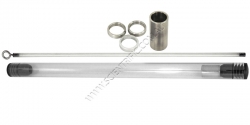
Enlarge

Enlarge
Induction Tube - Basic Kit
Order code: SC1090
Our Basic Induction Kit allows you to perform basic experiments and investigations into magnetism, magnetic fields, induced currents, eddy currents, Lenz's Law and magnetic braking.
The kit consists of a clear plastic tube containing a cylindrical neodymium iron boron 'super magnet'. A central hole extends through the tube's end stops and rubber bumpers.
Used at it simplest the tube can be inverted back and forth allowing the magnet to drop, used in this way the user will get a feel for the magnets movement, collision with the end stops, the weight of the apparatus while at rest and with the magnet falling.
A plastic draw rod is supplied with a small ferrous tip at one end. Inserting the draw rod into the tube and allowing the ferrous tip end to attach to the magnet enables you to draw the magnet back and forth back by hand. The other end of the draw rod has a hook which allows you to connect the draw rod to mechanical devices, e.g. a small motor with a drive cam, to study repetitive motion effects.
Also included are a short aluminium tube and 3 rings which fit neatly over the Induction Tube. One of the rings is of plastic but painted to look like aluminium, the other two rings are aluminium however one has a slot cut in it.
Individually slipping the rings over the Induction Tube and drawing the magnet back and forth allows the study of induced EMF and eddy currents in non-ferrous materials. The Induction Tube can be used both horizontally and vertically while experimenting with the rings and short aluminium tube.
Standing the Induction Tube vertically while holding magnet (via the drawer rod) at the top of the tube allows you to study what happens when the draw rod is removed and the magnet falls through the rings or the short aluminium tube. This is a great demonstration of how magnetic brakes work in amusement park rides. Experiments can be designed to examine the best placement of the rings or the short aluminium tube for best effects.
This basic kit is ideal for both primary and early secondary schools.
Note some ancillary equipment like retort stands, bossheads etc may be required for best functionality.
Kit contents:
• Induction Tube (Plastic Tube with cylindrical magnet, axially magnetised North/South)
• Control Rod (to control magnet position and motion)
• Aluminium Tube (L 60mm)
• Aluminium Ring (continuous)
• Aluminium Ring (with slit)
• Silvered Plastic Ring
Our advanced kit includes:
• a selection of cables to wind your own coils
• a pre-wound 600 turn coil
• coil retainers
• LEDs
Last edited 26th Apr 2024
Videos:
 This product is used in teaching these Australian Curriculum codes:
This product is used in teaching these Australian Curriculum codes:
ACSPH110 - Gravity and electromagnetism - Electromagnetism - A changing magnetic flux induces a potential difference; this process of electromagnetic induction is used in stepup and stepdown transformers, DC and AC generators, and AC induction motors
ACSPH111 - Gravity and electromagnetism - Electromagnetism - Conservation of energy, expressed as Lenz’s Law of electromagnetic induction, is used to determine the direction of induced current
ACSSU219 - Physical Sciences - Alternative Energies - Energy from a variety of sources can be used to generate electricity
ACSSU097 - Physical Sciences - Electrical Circuits - Electrical energy can be transferred and transformed in electrical circuits and can be generated from a range of sources
Click a curriculum code to see other products that relate.
Documents: Catalogue | Scientrific April 2025 Mini Catalogue | Catalogue | Vernier 2025 K-12 Catalogue | Catalogue | Vernier 2025 University Catalogue | Experiment | Induction Investigation | Experiment | SP33A E-M Induction | | |||||||||||
Note: Prices do NOT include GST or freight


